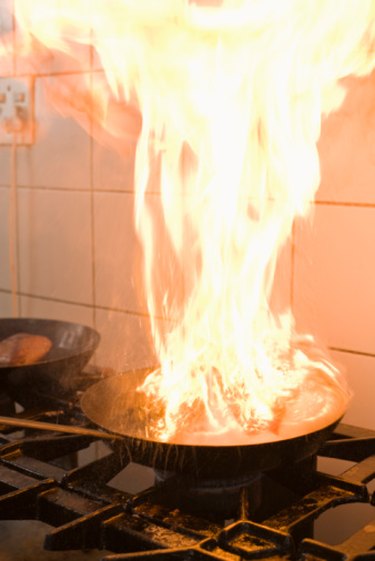Things You'll Need
Window fans
Bucket
Measuring spoon and cup
Tri-sodium phosphate (TSP)
Chlorine bleach or all-purpose cleaner
Rubber gloves
Sponge
Mild liquid dishwashing detergent
Dishcloth
White distilled vinegar
Table salt
Dish towel
Small bowls
Wallpaper paste (optional)
Wet/dry vacuum (optional)
Vacuum cleaner with attachments (optional)

Small fires occur in kitchens due to distractions while cooking, a flare-up of grease or a faulty appliance. This leaves soot, a foul odor and unsightly residue on the surfaces of your kitchen countertop, ceilings, walls and floor. Cleaning the area properly helps remove the odor, stains and debris from the fire. A fire restoration company is often necessary after a large fire, but homeowners can clean up after a small fire quickly by using the right products.
Cleaning Walls, Ceilings, Furniture and Floors
Step 1
Open all the windows and doors to ventilate the kitchen. This helps remove smoke odor and the fumes. Set an exhaust fan near or in your window frame, if you have one. Position the fan so that it sucks out the air in the kitchen and blows it outside.
Video of the Day
Step 2
Mix a solution of 6 tbsp. of tri-sodium phosphate, 1 cup of chlorine bleach and 1 gallon of warm water. Tri-sodium phosphate is a caustic yet effective cleaner, therefore wear rubber gloves while using the solution.
Step 3
Scrub the walls, furniture and floors with a sponge dipped into the solution and wrung out well.
Step 4
Rinse the areas well with clear water and dry the surfaces with a soft towel.
Cleaning Pots, Pans and Flatware
Step 1
Wash the pots, pans and flatware with a mild, liquid dishwashing detergent and a dishcloth.
Step 2
Rinse the pots, pans and flatware well with clear water.
Step 3
Scrub the kitchen cookware or flatware with a fine-powder cleanser. Another effective method is to saturate a dishcloth with vinegar. Wring the dishcloth well and sprinkle regular table salt on it. Use the dishcloth to scrub any residue or stains that result from the fire.
Step 4
Rinse all the items well and dry with a dish towel.
Tip
Set out small bowls of vinegar in the kitchen and other areas where the smoke odor remains. Vinegar neutralizes and absorbs the odor after a couple of hours.
Tri-sodium phosphate is available at discount, hardware and home supply stores.
Test any textured, painted or wallpaper finishes before using bleach on them. Mix 1 cup chlorine bleach with one gallon of water. Apply the mixture to a small area with a sponge and wait 24 hours. Check for discoloration or spotting, if the area looks fine you can use the bleach solution.
Wipe down all counter surfaces with 1 cup chlorine bleach to one gallon of water. This prevents mold and mildew from growing and effectively sanitizes the area.
Avoid getting washable wallpaper too damp during the cleaning process. This may cause it to peel. If seams or edges loosen or peel, use wallpaper paste to glue them back into place. Clean the wallpaper from the bottom to the top.
Use a wet/dry vacuum to clean up any wet debris as a result of putting out the fire. Vacuum attachments are handy to remove soot and other debris from hard-to-reach areas. (see ref 2 bullets 1 & 2)
Warning
Never mix bleach with ammonia-containing products. This results in toxic fumes.
Video of the Day